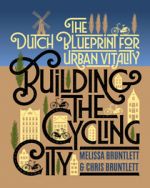Building the Cycling City: The Dutch Blueprint for Community Vitality

Building the Cycling City is authored by a Canadian couple, who decided to give up their car as a lifestyle experiment. They and their young children became so invested in the new lifestyle that they spent 5 weeks cycling around the Netherlands, and came home eager to document what they had seen.
The Bruntletts explain: “At the end of the day, our family doesn’t identify ourselves as “car-free,” nor are we stubborn radicals determined to save the world. We chose simple means—walking or cycling—for the majority of our daily trips because they are the most practical, efficient, and enjoyable ways to get from A to B. More families like ours will choose these healthier, happier means once our cities make them not just safe and convenient, but also delightful.” (page xiii)
They call the Netherlands “the world’s foremost cycling nation”, and the only one to have more bikes than people (page 1). Cycling is apparently so embedded in the Dutch culture that the language has two words for cyclist: wielrenner (“wheel runner”, or serious sport cyclists, a minority) and fietster (the majority).
Building the Cycling City posits that the intensity of Dutch cycling isn’t related to cultural or geographical factors, but political ones: extensive bike lanes, separated from cars, and traffic-calmed streets with low speed limits. The benefits of the political decision to invest in cycling are numerous, including quality of life, health, environment, cost savings (fewer traffic accidents and emergency callouts) and even driving experiences (as people aren’t required or pressured to drive, and can have pleasant associations with it).
The book delves into the history of planning in Dutch cities, such as the overhaul that followed Rotterdam’s bombing during World War II, to show that the Netherlands’ cycling-friendliness isn’t just an accident. Yet the authors stress that other locations can’t simply copy the Dutch methods. Obviously planners can’t wait for city centres to be levelled during wartime in order to build back better, for instance. So the book also draws comparisons between Dutch cities and North American ones, some of which have explicitly drawn on the Netherlands for inspiration. In Austin, Texas, for instance, cycling advocates have had to build both a cultural and economic case for cycling infrastructure, in a state where the car is king.
Building the Cycling City is almost unflaggingly optimistic, for instance in its vision of cargo bikes for goods delivery and family transport (although there may be an uglier side to these cargo bikes as a symbol of gentrification). The book also lauds the Dutch system of bike education, for socializing both children and migrants into the Dutch way—although this may not grapple with cultural issues that affect migrants’ propensity to cycle, for instance.
Written by cycling enthusiasts, not academics, Building the Cycling City is an accessible read.
Further reading:
Newman, Peter (1996), “Reducing automobile dependence”, Environment and Urbanization Vol 8, No 1, pages 67–92, available at http://journals.sagepub.com/doi/pdf/10.1177/095624789600800112.
Pucher, John and Ralph Buehler (2017), “Cycling towards a more sustainable transport future”, Transport Reviews Vol 37, No 6, pages 689–694, available at https://www.tandfonline.com/doi/full/10.1080/01441647.2017.1340234.
Book note prepared by Christine Ro
Search the Book notes database
Our Book notes database contains details and summaries of all the publications included in Book notes since 1993 - with details on how to obtain/download.
Use the search form above, or visit the Book notes landing page for more options and latest content.
For a searchable database for papers in Environment and Urbanization, go to http://eau.sagepub.com/

